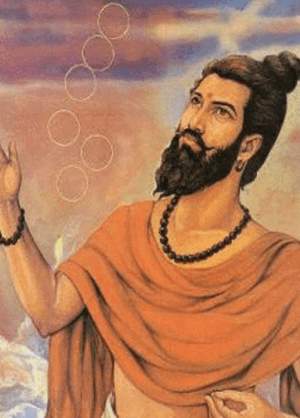Kaṇāda (philosopher) facts for kids
Quick facts for kids
Kaṇāda
|
|
|---|---|

Maharishi Kanada
|
|
| Born | Unclear, 6th – 2nd century BCE |
| Region | Indian philosophy |
| School | Vaisheshika |
|
Main interests
|
|
|
Notable ideas
|
Atomism |
Kaṇāda (Sanskrit: कणाद, romanized: Kaṇāda) was an ancient Indian scientist and thinker. He is also known by names like Ulūka, Kashyapa, Kaṇabhaksha, and Kaṇabhuj. He started the Vaisheshika school of Indian philosophy, which was also one of the first Indian schools of physics.
Kaṇāda probably lived between the 6th and 2nd centuries BCE, but not much is known about his life. His name "Kaṇāda" means "atom eater." He is famous for developing the first ideas about atomism in India. He wrote his ideas in a Sanskrit book called Vaiśeṣika Sūtra, which is also known as Kaṇāda Sutras.
The Vaisheshika school, started by Kaṇāda, explains how the universe was made and how it works. It uses an atomic theory, logic, and realism. This was one of the first times in history that someone tried to explain reality in such a detailed and systematic way. Kaṇāda believed that everything can be broken down into smaller parts. But this breaking down can't go on forever. Eventually, you reach tiny, unbreakable particles called paramanu, or atoms. These atoms are eternal. They combine in different ways, often with heat, to create all the different things we see in the world. He also connected these ideas to the concept of Atman (the soul or self) to explain how people could find inner peace.
Kaṇāda's system talks about six main properties or categories (padārthas) that can be named and known. He said these six things are enough to describe everything in the universe, including us. These categories are: substance (dravya), quality (guna), motion (karmana), time (samaya), particularity (visesa), and inherence (samavaya). There are nine types of substances, some are atomic (like atoms), some are not, and some are everywhere.
Kaṇāda's ideas covered many areas. They influenced not only philosophy but also other fields. For example, they might have influenced Charaka, who wrote an important medical book called Charaka Samhita.
Contents
When Did Kaṇāda Live?
The exact time when Kaṇāda lived is not clear and has been debated for a long time. Some experts think he lived before 300 CE. However, it's hard to find strong proof for a specific century.
The Vaisheshika Sutras mention other Indian philosophies like Samkhya and Mimamsa. But they don't mention Buddhism. This has led some scholars to believe Kaṇāda lived as early as the 6th century BCE. The Vaisheshika Sutras book has survived in different versions. New discoveries of old copies suggest the text was put into its final form between 200 BCE and the start of the common era. However, its main ideas might be much older. Many Hindu books from the 1st and 2nd centuries CE mention and discuss Kaṇāda's ideas. Buddhist texts from the same time also talk about his teachings.
In Jainism writings, Kaṇāda is called Sad-uluka. This means "the Uluka who taught the idea of six categories." His Vaisheshika philosophy is also sometimes called "Aulukya philosophy," which comes from his nickname Uluka.
Kaṇāda was very important in Indian philosophies. He appears in different texts with various names like Kashyapa, Uluka, Kananda, and Kanabhuk.
Kaṇāda's Key Ideas
Kaṇāda believed that understanding movement was key to knowing about the universe. He thought that all things we can know are based on motion. He also had ideas about how things stay the same. For example, he said that an atom must be round because it should look the same from all sides. He stated that all substances are made of four types of atoms. Two of these atoms have mass (weight), and two do not.
Kaṇāda also connected his scientific ideas with good living. He said that true knowledge, or Dharma, helps people make progress in life and achieve the highest good. He believed that the ancient texts called the Vedas are respected because they teach this kind of Dharma. But he also said that something is not Dharma just because it is in the Vedas.
Kaṇāda and other early Vaisheshika scholars focused on how the universe developed through natural laws. This was common for his time. Many early Hindu philosophies, as well as non-Vedic schools like Jainism and Buddhism, also explored ideas without focusing on a god. Kaṇāda was one of the wise people in India who believed that humans could understand existence and find inner peace on their own.
His book states some important ideas:
- There are nine basic parts of reality: four types of atoms (earth, water, light, and air), akasha (space), kāla (time), disha (direction), an endless number of souls (Atman), and manas (mind).
- Everything created is made of atoms (paramāṇu). These atoms connect to form molecules (aṇu). Atoms are eternal, and their combinations make up the physical world we see.
- Individual souls are eternal and live inside physical bodies for a time.
- There are six categories of experience: substance, quality, activity, generality, particularity, and inherence.
Kaṇāda also listed several features of substances (dravya), such as color, taste, smell, touch, number, size, how things are separate, how they join and unjoin, and feelings like pleasure and pain.
This idea of breaking things down into smaller parts also applies to how we understand categories. This is why Kaṇāda's ideas are similar to the Nyaya school of philosophy.
Observations and Theories
In the fifth chapter of the Vaisheshika Sutra, Kaṇāda talks about many things he observed in nature. These include objects falling to the ground, fire and heat rising, grass growing upwards, rain and thunderstorms, liquids flowing, and magnets attracting things. He asked why these things happen. Then, he tried to connect his observations with his theories about atoms, molecules, and how they interact. He divided observed events into two types: those caused by a choice or will, and those caused by how objects interact with each other.
His idea that the observer (the person watching) is different from objective reality (what is being watched) fits well with Vedanta philosophy. Vedanta talks about two kinds of knowledge: "Apara" (normal knowledge from senses) and "Para" (deeper, inner knowledge).
The Concept of Paramāṇu (Atom)
Kaṇāda suggested that paramāṇu (atom) is a tiny, unbreakable particle of matter. He said an atom cannot be divided because it's so small that you can't measure it. He used logical arguments to figure out what atoms are like. He also stated that an anu (a molecule, or combination of atoms) can be in two states: completely still or in motion.
Kaṇāda thought there were four different kinds of atoms. Two of them had mass (weight), and two did not. He believed that every substance is made up of all four kinds of atoms.
Kaṇāda's idea of the atom was likely developed independently from similar ideas in ancient Greece. This is because there are differences between their theories. For example, Kaṇāda believed that atoms, as building blocks, were different in both their qualities and quantities. The ancient Greeks, however, thought that atoms differed only in quantity (like size or shape), but not in their basic qualities.
See also
 In Spanish: Kanada para niños
In Spanish: Kanada para niños





